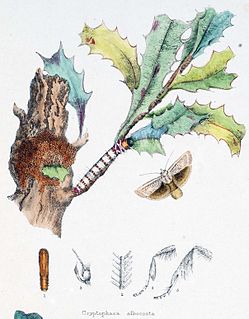Related Research Articles

Eublemma minutata, the scarce marbled, is a species of moth of the family Erebidae. It can be found everywhere in Europe, except for Luxembourg, the Netherlands, the northern part of Russia and various islands. In Asia, it can be found only in Lebanon.

Xyloryctidae is a family of moths contained within the superfamily Gelechioidea described by Edward Meyrick in 1890. Most genera are found in the Indo-Australian region. While many of these moths are tiny, some members of the family grow to a wingspan of up to 66 mm, making them giants among the micromoths.

Cryptophasa is a genus of moths of the family Xyloryctidae.
Cryptophasa neocrates is a moth in the family Xyloryctidae. It was described by Edward Meyrick in 1925. It is found on New Guinea.
Cryptophasa nesograpta is a moth in the family Xyloryctidae. It was described by Edward Meyrick in 1925. It is found on New Guinea.
Cryptophasa phaeochtha is a moth in the family Xyloryctidae. It was described by Edward Meyrick in 1925. It is found on New Guinea.
Cryptophasa psammochtha is a moth in the family Xyloryctidae. It was described by Edward Meyrick in 1925. It is found on New Guinea.
Cryptophasa vacuefacta is a moth in the family Xyloryctidae. It was described by Edward Meyrick in 1925. It is found on New Guinea.
Cryptophasa merocentra is a moth in the family Xyloryctidae. It was described by Edward Meyrick in 1925. It is found on Buru in the Maluku Islands.
Cryptophasa mesotoma is a moth in the family Xyloryctidae. It was described by Edward Meyrick in 1925. It is found on Buru in the Maluku Islands.
Cryptophasa chionotarsa is a moth in the family Xyloryctidae. It was described by Edward Meyrick in 1925. It is found on New Guinea.
Cryptophasa crocochorda is a moth in the family Xyloryctidae. It was described by Edward Meyrick in 1925. It is found on New Guinea.
Cryptophasa curialis is a moth in the family Xyloryctidae. It was described by Edward Meyrick in 1925. It is found on New Guinea.
Cryptophasa ensigera is a moth in the family Xyloryctidae. It was described by Edward Meyrick in 1925. It is found on New Guinea.
Cryptophasa semnocrana is a moth in the family Xyloryctidae. It was described by Edward Meyrick in 1928. It is found on New Britain in Papua New Guinea.
Cryptophasa phaethontia is a moth in the family Xyloryctidae. It was described by Edward Meyrick in 1890. It is found in Australia, where it has been recorded from Queensland.
Cryptophasa rubra is a moth in the family Xyloryctidae. It was described by Edward Meyrick in 1890. It is found in Australia, where it has been recorded from South Australia, Victoria and Western Australia.
Cryptophasa sarcinota is a moth in the family Xyloryctidae. It was described by Edward Meyrick in 1890. It is found in Australia, where it has been recorded from Queensland.
Paralecta amplificata is a moth in the family Xyloryctidae. It was described by Meyrick in 1925. It is found in New Guinea.

Asaphodes cosmodora is a species of moth in the family Geometridae. This species is endemic to New Zealand.
References
- ↑ Savela, Markku, ed. (April 25, 2016). "Cryptophasa amphicroca Meyrick, 1925". Lepidoptera and Some Other Life Forms. Retrieved August 24, 2020.
- ↑ Exotic Microlepidoptera. 3 (5-7): 151.
| This article on a moth of the family Xyloryctidae is a stub. You can help Wikipedia by expanding it. |